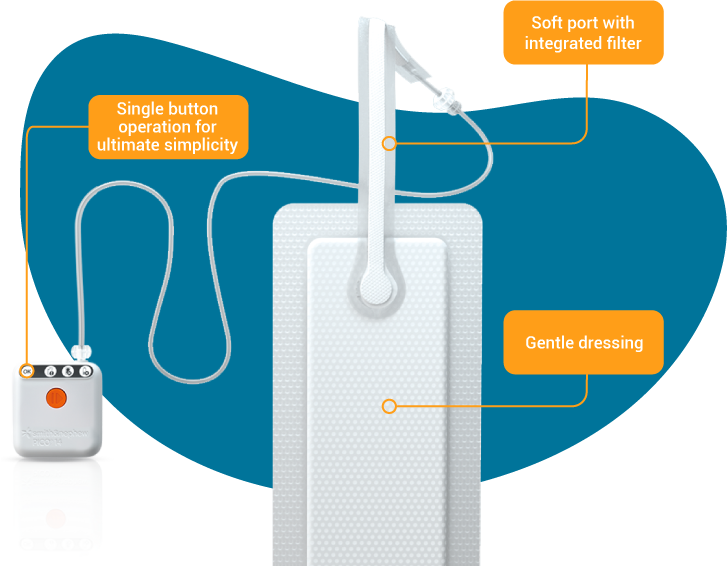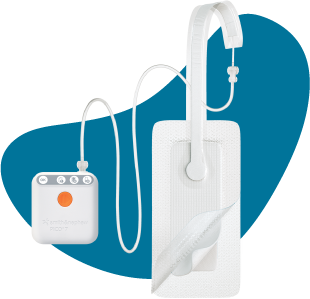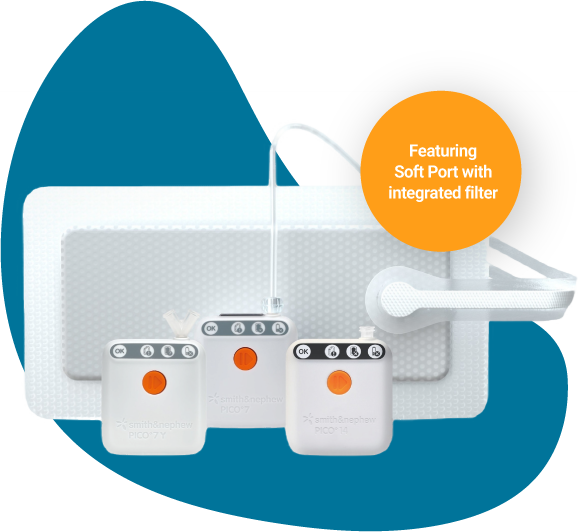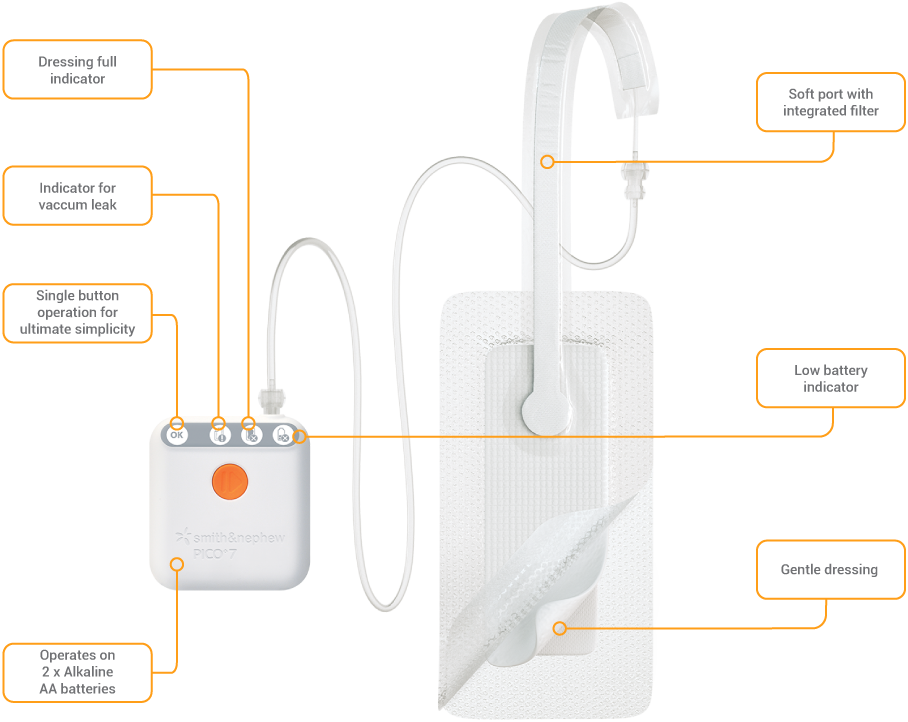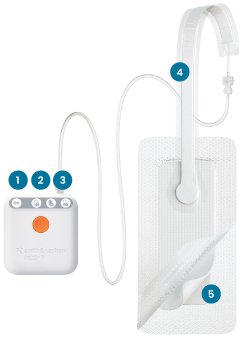PICO◊
PICO Negative Pressure Wound Therapy recorded significant improvements in quality of scarring in patients over various periods of time.
Single Use Negative Pressure Wound Therapy System
Healthcare professionals find the PICO◊ wound dressing easy to use and patients gave it a high score for comfort.
A single use negative pressure system reduces surgical site complications compared with conventional dressings in closed surgical incisions: a systematic literature review with meta-analysis.
- PICO◊ systems are suitable for use both in a hospital and homecare setting.
- PICO◊ has a strong evidence base. To date, 146* clinical publications regarding PICO have been identified.
Single Use Negative Pressure Wound Therapy System
Technology is completely portable and clinically effective in the treatment of surgical, chronic and acute wounds.
Find Out More & Start Saving Today!
Discover unbeatable savings and hassle-free supply with Pipeline Medical!
PICO: Single Use Negative Pressure Wound Therapy System for Wound Care
Why Advanced Wound Management Solutions Matter in Modern Healthcare
For medical practices specializing in wound care, finding efficient, evidence-based treatment options remains an ongoing challenge. Traditional wound dressings often fall short when managing complex wounds, leading to extended healing times, increased risk of complications, and diminished patient satisfaction. These challenges directly impact both clinical outcomes and practice efficiency.
The consequences of suboptimal wound management extend far beyond the wound itself. Patients experience prolonged discomfort, increased risk of infection, and potentially extended hospital stays. Medical practices face higher treatment costs, resource utilization, and administrative burden. The compounding effects of these challenges create significant strain on the entire healthcare ecosystem.
Hard-to-heal wounds represent a particularly significant challenge for medical professionals. These wounds, characterized by delayed healing trajectories, increased complexity, and higher risk of complications, demand more advanced therapeutic approaches than conventional dressings can provide. Without effective intervention, these wounds can lead to serious complications including infection, tissue necrosis, and in severe cases, amputation.
Your medical practice deserves access to cutting-edge wound care solutions that enhance patient outcomes while optimizing clinical resources. Your patients deserve treatments that accelerate healing, reduce complications, and improve their quality of life during recovery.
How PICO Single Use Negative Pressure Wound Therapy Transforms Wound Management
Innovative medical practices recognize that advanced wound care technology directly correlates with superior patient outcomes. By implementing single use negative pressure wound therapy systems, forward-thinking clinicians achieve remarkable improvements in wound healing trajectories while enhancing operational efficiency.
PICO negative pressure wound therapy system differs fundamentally from traditional wound care approaches in three key ways:
Revolutionary Canister-Free Technology Enhances Patient Mobility
Traditional negative pressure wound therapy (NPWT) devices rely on bulky canisters to collect exudate, significantly limiting patient mobility and often requiring hospitalization throughout the treatment period. This approach creates substantial barriers to recovery, particularly for ambulatory patients who benefit from movement and normal activity.
PICO SNPWT utilizes innovative canister-free technology that revolutionizes the patient experience. Rather than collecting fluid in external containers, PICO’s advanced dressing technology effectively manages exudate through superior absorption and evaporation capabilities. This design breakthrough enables patients to maintain normal mobility throughout treatment, supporting faster recovery and improved quality of life during the healing process.
Simplified Application Improves Clinical Efficiency
Conventional NPWT systems often involve complex setup procedures, multiple components, and significant clinician training requirements. This complexity creates barriers to adoption and increases the risk of application errors that can compromise therapeutic efficacy.
PICO’s streamlined design dramatically simplifies the application process for healthcare professionals. The intuitive pump and dressing system can be applied in minutes without specialized equipment or extensive training. This simplified approach reduces procedural time, minimizes the risk of application errors, and enables more consistent therapy delivery across diverse clinical settings from hospital environments to outpatient clinics.
Enhanced Portability Supports Transitional Care Excellence
Traditional NPWT systems typically require patients to remain in hospital settings throughout treatment due to device size, power requirements, and monitoring needs. This extended hospitalization increases healthcare costs and exposes patients to hospital-associated risks.
PICO’s compact, lightweight design enables seamless transitions between care settings. The pocket-sized pump and self-contained dressing system maintains the negative pressure consistently for up to 7 days, allowing patients to continue effective therapy at home after initial treatment in clinical settings. This portability supports earlier discharge, reduced hospitalization costs, and improved patient satisfaction without compromising therapeutic efficacy.
What PICO Negative Pressure Wound Therapy Delivers for Medical Practices
When medical practices implement PICO negative pressure wound therapy, the benefits extend far beyond basic wound management. This innovative system delivers comprehensive value across multiple dimensions of patient care and practice operations.
Superior Clinical Outcomes Through Advanced PICO SNPWT Technology
Effective wound management requires technologies that actively support the healing process while mitigating risk factors for complications. Traditional dressings provide passive protection but fail to create the optimal healing environment needed for challenging wounds.
PICO’s innovative technology delivers continuous negative pressure that actively supports wound healing through multiple mechanisms of action. The system removes excess exudate and infectious materials while reducing edema in surrounding tissues. Simultaneously, it helps approximate wound edges, enhances perfusion, and stimulates granulation tissue formation. This comprehensive approach addresses multiple aspects of the wound healing process simultaneously, creating conditions that support faster, more effective healing.
Clinical studies demonstrate that PICO SNPWT significantly improves outcomes for various wound types:
- Remarkable improvements in closed surgical incisions with reduced surgical site infection rates
- Accelerated healing trajectories for traumatic wounds requiring immediate intervention
- Significant progress in hard-to-heal wounds that previously showed limited improvement
- Substantial reductions in exudate management challenges for highly draining wounds
These outcomes translate directly to enhanced patient satisfaction, reduced complication rates, and improved clinical efficiency within your medical practice.
Enhanced Patient Experience Through Patient-Centric Features
Patient compliance and satisfaction significantly impact wound healing success. Traditional NPWT systems often create substantial burdens for patients including mobility restrictions, sleep disruption, and lifestyle limitations that reduce treatment adherence.
PICO’s design prioritizes patient experience through multiple patient-centric features:
- Ultra-quiet pump operation enables undisturbed sleep during treatment periods
- Low-profile dressing maintains patient dignity by remaining discreet under clothing
- Portable, lightweight design allows patients to maintain normal daily activities
- Simple interface reduces anxiety associated with complex medical equipment
- Waterproof dressing enables showering and normal hygiene routines during therapy
These features collectively enhance patient compliance, improve satisfaction scores, and support better overall treatment outcomes. For medical practices, these benefits translate to higher patient satisfaction ratings and improved reputation within your community.
Streamlined Operational Efficiency for Medical Practices
Wound care can create significant operational challenges for medical practices including inventory management complexity, extensive staff training requirements, and reimbursement challenges. Traditional NPWT systems often exacerbate these challenges through complex components and procedures.
PICO’s streamlined approach simplifies wound care operations in several key ways:
- Single-use system eliminates reprocessing requirements and cross-contamination risks
- All-in-one packaging reduces inventory management complexity
- Intuitive application requires minimal staff training
- Up to 7-day wear time reduces dressing change frequency and associated costs
- Comprehensive documentation supports straightforward reimbursement processes
These operational advantages allow your medical practice to provide advanced wound care without excessive administrative burden or resource allocation. The result is more efficient clinical operations without compromising care quality.
How to Implement PICO Negative Pressure Wound Therapy in Your Practice
Integrating PICO SNPWT into your wound care protocols requires thoughtful planning and strategic implementation. The following framework provides a practical roadmap for medical practices seeking to enhance their wound management capabilities.
Identifying Optimal Patient Candidates for PICO Therapy
Effective implementation begins with identifying the patients who will benefit most from PICO negative pressure wound therapy. While the system offers versatility across multiple wound types, certain clinical scenarios demonstrate particularly impressive outcomes:
- Surgical patients with closed incisions at high risk for complications
- Patients with moderately exuding open wounds requiring negative pressure support
- Individuals with hard-to-heal wounds showing limited progress with conventional dressings
- Patients requiring effective therapy in home or outpatient settings
- Cases where mobility and quality of life during treatment are high priorities
A systematic assessment approach helps identify ideal candidates by evaluating wound characteristics, exudate levels, infection risk, and patient lifestyle factors. This targeted selection ensures optimal resource utilization while maximizing clinical benefit.
Understanding PICO Application Techniques for Various Wound Types
PICO’s versatility extends across multiple wound classifications, each requiring specific application considerations for optimal outcomes. Mastering these techniques enhances therapeutic efficacy and clinical confidence:
- For closed surgical incisions: Apply the dressing centered over the incision line, ensuring at least 5 cm margin beyond the incision ends
- For open wounds: Position the dressing to cover the wound bed completely with appropriate sizing (up to 10 cm width)
- For irregular wounds: Consider using multiple dressings or supplementary border dressings to achieve appropriate seal
- For challenging anatomical locations: Utilize the flexibility of the dressing to conform to the specific contours
While application techniques vary by wound type, certain principles remain constant including proper skin preparation, appropriate sizing, and effective sealing to maintain negative pressure throughout the therapy duration. Please see the instructions for use for complete application guidance.
Implementing Effective Follow-Up Protocols
Optimizing PICO therapy outcomes requires strategic follow-up protocols tailored to both wound type and patient characteristics. Effective monitoring ensures timely intervention if needed while supporting efficient resource utilization:
- Establish clear documentation standards for baseline wound assessment
- Develop structured evaluation schedules based on wound complexity
- Train staff on recognizing both positive progress indicators and warning signs
- Create protocols for addressing dressing integrity issues or pump alarms
- Establish clear criteria for therapy continuation or transition to alternative treatments
These structured approaches prevent both insufficient monitoring and excessive clinical visits, creating an efficient balance that supports optimal healing while respecting clinical resource limitations.
Advancing Wound Care With PICO: Clinical Applications and Outcomes
PICO negative pressure wound therapy offers versatility across numerous clinical scenarios. Understanding specific applications helps medical practices leverage this technology for maximum patient benefit across diverse clinical needs.
Optimizing Outcomes for Closed Surgical Incisions
Surgical site complications represent a significant challenge for both patients and medical practices. Traditional dressings provide basic protection but offer limited active intervention to prevent complications in high-risk cases.
PICO SNPWT delivers superior outcomes for closed surgical incisions through multiple mechanisms:
- Active removal of fluid accumulation that can harbor bacteria
- Reduction of lateral tension across the incision line
- Enhanced tissue perfusion supporting optimal healing conditions
- Protection against external contamination throughout the recovery period
Clinical studies demonstrate that PICO therapy reduces surgical site infection rates by up to 50% in high-risk procedures when compared to standard dressings. This significant improvement translates directly to improved patient outcomes, reduced readmissions, and enhanced practice efficiency.
Accelerating Healing for Hard-to-Heal Wounds
Hard-to-heal wounds present particularly challenging management scenarios often requiring extended treatment periods and substantial clinical resources. These wounds, characterized by complex underlying pathology and delayed healing trajectories, benefit significantly from PICO therapy.
The system’s mode of action specifically addresses multiple barriers to healing in chronic wounds:
- Manages excessive exudate that can macerate surrounding tissues
- Reduces edema that impairs nutrient delivery to healing tissues
- Stimulates perfusion in compromised vasculature supporting oxygen delivery
- Promotes granulation tissue formation essential for wound closure
- Creates a controlled healing environment protected from external contamination
For medical practices managing patients with hard-to-heal wounds, PICO offers a solution that can break the cycle of delayed healing and initiate progressive improvement even in challenging cases.
Enhancing Outpatient Management of Acute Wounds
Traumatic wounds and other acute injuries often require negative pressure support, traditionally necessitating extended hospitalization or complex home care arrangements. PICO’s unique design enables effective outpatient management of these wounds without compromising therapeutic efficacy.
The system supports successful outpatient treatment through several key features:
- Simple application suitable for outpatient clinical settings
- Clear, intuitive patient instructions for home monitoring
- Portable design supporting patient mobility and independence
- Reliable operation without complex maintenance requirements
- Discreet profile allowing normal clothing and social activities
These attributes collectively enable medical practices to provide hospital-grade negative pressure therapy in outpatient environments, reducing hospitalization costs while improving patient satisfaction throughout the recovery process.
Understanding PICO Product Features and Technical Specifications
PICO negative pressure wound therapy incorporates multiple innovative technologies that collectively deliver superior wound management capabilities. Understanding these features helps medical practices leverage the system’s full potential for patient care.
Advanced NPED Technology Optimizes Exudate Management
The new negative pressure enhanced dressing (NPED) technology at the core of PICO represents a significant advancement in wound care engineering. This innovative approach combines multiple functional layers to effectively manage wound environments without external canisters.
The multilayer dressing system includes:
- Silicone adhesive layer that protects periwound skin while maintaining seal
- Perforated wound contact layer that promotes direct negative pressure transmission
- Absorbent core that effectively captures and locks away exudate
- Evaporative film that allows moisture vapor transmission while maintaining bacterial barrier
- Proprietary airlock technology that maintains therapy even when dressing is compressed
This integrated approach effectively handles exudate management through both absorption and evaporation mechanisms, eliminating the need for collection canisters while maintaining effective negative pressure at the wound surface.
Intuitive Pump Design Enhances Usability and Compliance
PICO’s pump unit exemplifies thoughtful design that prioritizes both functionality and user experience. Unlike traditional electrical medical equipment that can intimidate patients and complicate clinical application, PICO’s pump offers sophisticated capability in a remarkably user-friendly package.
Key pump features include:
- Single-button operation minimizing training requirements
- Clear visual indicators communicating system status
- 7-day battery life supporting extended therapy
- Constant pressure delivery without manual adjustments
- Automatic air leak detection with visual alerts
- Ultra-quiet operation supporting undisturbed sleep
These design elements collectively ensure reliable operation while minimizing the technical barriers that often impede adoption of advanced medical technologies. For both clinicians and patients, this simplicity translates to confidence and consistent therapy delivery.
Versatile Sizing Options for Diverse Clinical Applications
Wound characteristics vary dramatically across patient populations, requiring flexible solutions that adapt to specific clinical needs. PICO’s diverse dressing options accommodate this variability without compromising therapeutic efficacy or ease of use.
Available dressing configurations include:
- Multiple dimensions supporting wounds of various sizes up to 400cm²
- Multisite dressings for managing multiple smaller wounds simultaneously
- Specialized shapes optimized for challenging anatomical locations
- Extended dressing options for larger wounds requiring broader coverage
This versatility enables medical practices to maintain consistent PICO therapy protocols across diverse patient populations while optimizing both clinical outcomes and inventory management.
Frequently Asked Questions About PICO Negative Pressure Wound Therapy
What types of wounds can be treated with PICO therapy?
PICO negative pressure wound therapy demonstrates versatility across multiple wound classifications including:
- Closed surgical incisions, particularly those at elevated risk for complications
- Chronic wounds including diabetic foot ulcers, pressure injuries, and venous leg ulcers
- Acute wounds requiring advanced management approaches
- Traumatic wounds following appropriate surgical management
- Partial-thickness burns after appropriate initial treatment
- Skin grafts requiring enhanced stabilization during initial healing phases
While PICO offers impressive versatility, certain wound characteristics may indicate alternative treatment approaches. Please see the instructions for use for complete indication information and specific contraindications to ensure appropriate patient selection.
How does PICO compare to traditional negative pressure wound therapy systems?
PICO represents a significant advancement over traditional NPWT systems in several key dimensions while maintaining the core therapeutic benefits of negative pressure technology:
- Eliminates canisters through innovative dressing technology managing exudate through absorption and evaporation
- Reduces size and weight dramatically, enhancing portability and patient mobility
- Simplifies application and management, reducing clinical time requirements
- Operates silently, improving patient experience during extended therapy
- Enables therapy in diverse settings from hospital to home environments
- Reduces disposable component requirements, enhancing sustainability
These advantages make PICO particularly suitable for ambulatory patients, those transitioning between care settings, and individuals where quality of life during treatment represents a significant priority.
What is the typical treatment duration for PICO therapy?
PICO negative pressure wound therapy duration varies based on wound type, individual patient factors, and clinical response. However, general guidelines include:
- For closed surgical incisions: Typically 5-7 days, corresponding to the critical initial healing period
- For acute wounds: Often 1-2 weeks depending on progression and secondary closure options
- For chronic/hard-to-heal wounds: Frequently 4-8 weeks with regular reassessment of progress
- For skin grafts: Usually 3-5 days to support initial graft stabilization
Each dressing can remain in place for up to 7 days depending on exudate levels, with the single pump supporting continuous therapy throughout this period. This extended wear time reduces dressing changes, minimizes disruption to healing tissues, and enhances both clinical efficiency and patient comfort.
How is reimbursement handled for PICO SNPWT?
Reimbursement for PICO varies based on treatment setting, patient insurance, and specific wound characteristics. However, several key principles support successful reimbursement strategies:
- Comprehensive documentation of medical necessity based on wound assessment
- Clear recording of risk factors supporting advanced therapy selection
- Thorough wound measurement and characteristics documentation
- Appropriate procedure coding specific to care setting and wound type
- Regular progress documentation demonstrating therapeutic response
PICO’s single-use design and straightforward application often streamline the reimbursement process compared to more complex traditional NPWT systems. For specific coding guidance relevant to your practice location and patient population, consultation with reimbursement specialists is recommended.
What training is required for healthcare professionals to implement PICO therapy?
PICO’s intuitive design minimizes training requirements while maintaining therapeutic efficacy. Most healthcare professionals can implement the system effectively after brief orientation covering:
- Patient selection criteria and wound assessment
- Proper skin preparation and dressing application techniques
- Pump activation and status indicator interpretation
- Troubleshooting for common challenges such as leaks
- Documentation requirements for clinical and reimbursement purposes
The system’s simplified operation reduces the extensive training often required for traditional NPWT systems, enabling broader implementation across diverse clinical settings. Product specialists can provide in-service training tailored to your specific practice needs to ensure confident application by all relevant staff members.
Elevating Wound Care Practice Through PICO SNPWT Implementation
The intersection of clinical excellence and operational efficiency defines today’s most successful medical practices. As healthcare continues to evolve, advanced wound care technologies like PICO represent significant opportunities for practices to enhance both patient outcomes and operational performance.
PICO negative pressure wound therapy delivers a powerful combination of clinical efficacy and practical usability. The system’s innovative design addresses the limitations of traditional NPWT approaches while maintaining the proven benefits of negative pressure for wound healing. This balance of therapeutic power and practical implementation makes PICO particularly valuable for medical practices seeking to elevate their wound care capabilities.
Your medical practice deserves access to wound care solutions that enhance patient outcomes without creating operational complexity. Your patients deserve treatments that support both physical healing and quality of life throughout the recovery process. PICO negative pressure wound therapy delivers on both these essential priorities.
Discover how PICO’s innovative approach to negative pressure wound therapy can transform your practice’s wound management capabilities. Our specialized solution helps medical practices achieve substantial improvements in healing outcomes while enhancing operational efficiency and patient satisfaction.
The information provided on this site is for informational purposes only and is not intended to substitute for professional medical advice, diagnosis, or treatment. Always consult a qualified healthcare provider or medical professional for guidance on any medical concerns, product use, or treatment decisions.
